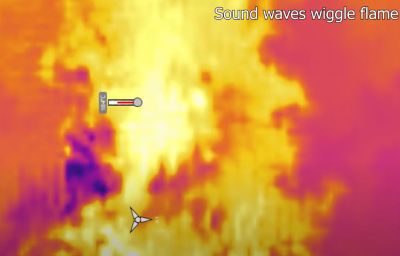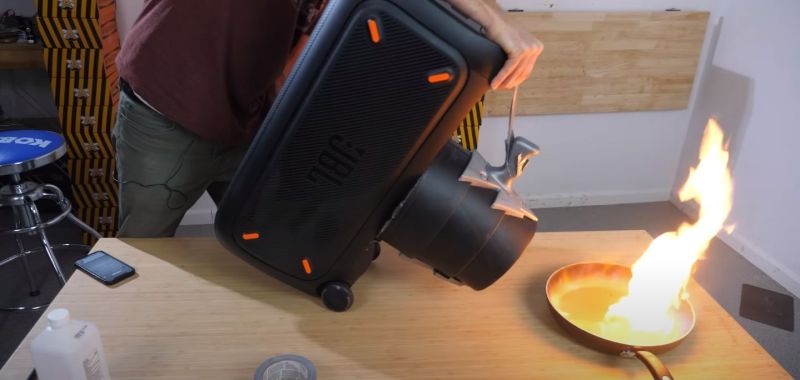In order for a fire to sustain itself, it needs three things: fuel, heat, and oxygen, with the disruption of just one of those causing the fire to extinguish. Water, sand, and carbon dioxide-based fire extinguishers are commonly used, but you’re probably familiar with blowing out a candle using your breath. Counter-intuitively, we also blow on a fire (or use bellows) to make it burn better, so what is happening here? Starting with a novelty app for smartphones that can be used to blow out small flames like candles, [The Action Lab] digs into the topic in a recent video.

Using a fairly beefy speaker to blast a 70 Hz tone at a big alcohol flame was not enough to extinguish it, but using the bass reflex port on the back was more effective, yet still not nearly enough. Using an air vortex cannon to focus the sound waves from the bass reflex port, it ‘wiggles’ the flame out in a matter of seconds, as illustrated with a thermal camera. Compared to the much stronger airflow from the box fan that was also used in one attempt, the difference with the sound waves is that they oscillate, constantly fluctuating the air pressure.
This churns the air and thus the flame around, diffusing the suspended fuel, cooling the air, and alternatingly pushing oxygenated air and carbon dioxide-heavy combustion fumes into the flame. This differs from the constant flow from the box fan, which only pushes oxygen-rich air into the flame, thus keeping it intact and burning brightly. Perhaps the main question that remains here is just how practical this approach is for extinguishing flames. Some commentators suggested using this approach in low- and zero-gravity situations, as found in space stations, where regular fire extinguishers based around smothering a flame aren’t as practical.
(Thanks to [Hyperific] for the tip)

















Red Adair did it better. He used TNT. https://www.youtube.com/watch?v=q0uGHaVZRM4
The Soviet Union did it even better. They used nukes to put out burning natural gas wells.
https://interestingengineering.com/science/soviet-engineers-detonated-a-nuke-miles-underground-to-put-out-a-gas-well-fire
Had a stereo that, with sealed cabinet (no band pass or tube port) and woofer at 94 db at 1 watt / 1 meter, would put out a zippo at 12 inches, heavy metal doube bass drum beat. And.. a few hundred watts of juicy juice. ;)
History repeats itself.
Hackaday covered “sound extinguishes a flame” years ago.
I want a excel sheet which music genre works for which type of fire :-)
And in case of fire it will not work because you didn’t pay the music license fees.
Dateline 1971, Misawa Japan
I owned a high-end Akai stereo system; my buddy had a Yamaha system. We used to take bets on whose system could blow out a candle farther from the woofer using a vinyl pressing of Steppenwolf’s Born to be Wild. As I recall, the Yamaha put the candle flame out at about 12.5″ while my Akai came in right at a foot. Unscientific but fun especially when long-neck Sapporo beer was involved.
You Sir are awesome!
So why not use a fire warning siren to do the job ?
Detail: @03:40 the fire mostly extinguishes itself because it is (almost) out of alcohol. There are only some small smidges left in the frying pan. The rest of the video after that mostly builds on the assumption the experiment @03:40 worked. I have not seen another demonstration of a flame of similar size in this video. The effect itself is interesting, but this video is not convincing.
I knew fires would be put out if I yelled at them loud enough!
that hurts the fire — the flames are yell-ow
Ok, if low frequency sound can put out a flame then why do blue angels exist?!?!?
3:19 for the impatient.
After the gulf war, they were using jet engines to blow out the flames on some of the oil stacks. Being that sound moves air, and we have been blowing out candles for millennia, does not seem surprising that you could in fact use a speaker to put out a flame.
Fire in space… where fire autosuffocate because there is no convection